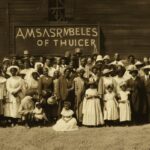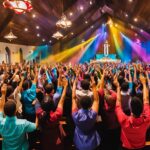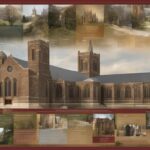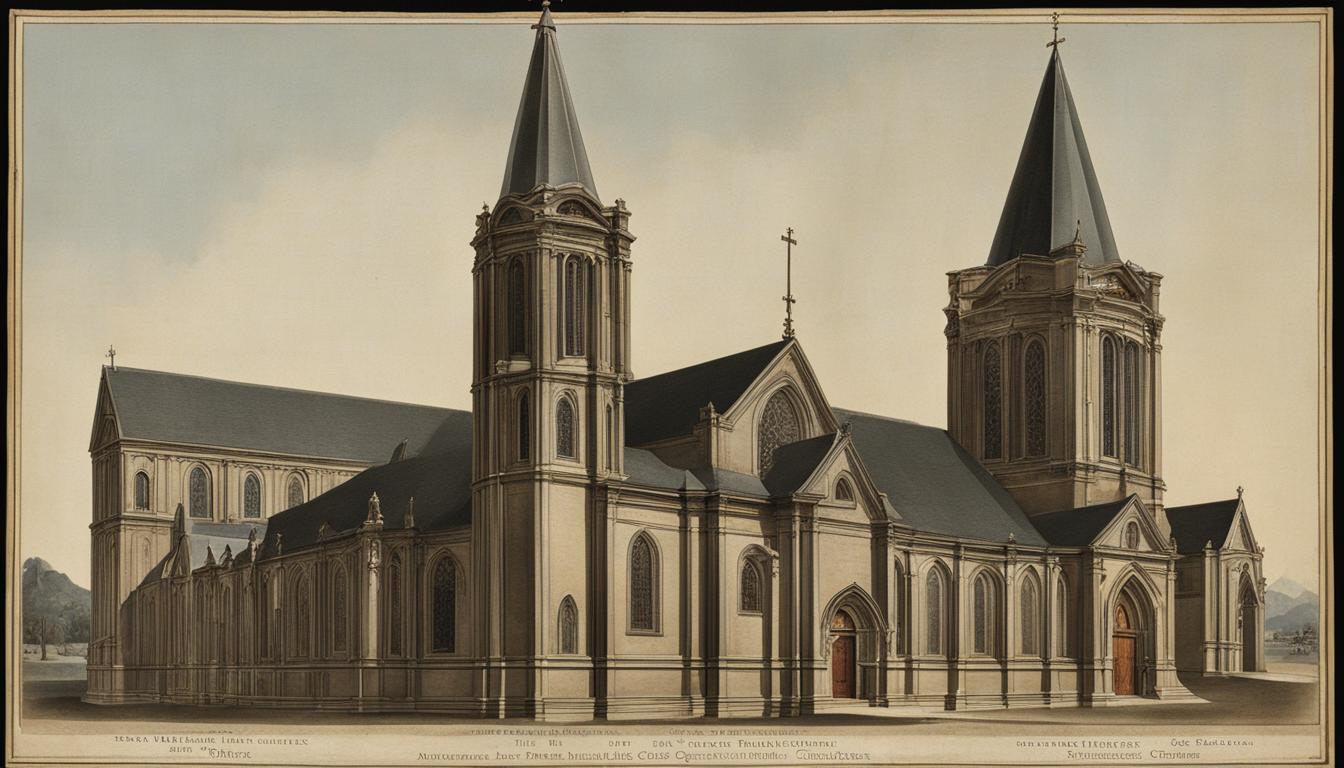The Assemblies of God (AG) is a vibrant Pentecostal church with a rich history that spans over a century. It originated from the Azusa Street Revival, a powerful spiritual movement that took place in the early 20th century. Influenced by the outpouring of the Holy Spirit, believers experienced miraculous signs and wonders, including speaking in tongues.
In 1911, several Pentecostal groups, including the Church of God in Christ and the Christian and Missionary Alliance, came together to officially establish the Assemblies of God. Since then, the AG has grown into an international fellowship with a presence in 190 countries, empowering millions of believers around the world.
The Assemblies of God holds firm to its foundational beliefs, emphasizing the full inspiration and authority of the Bible, the Trinitarian nature of God, and the necessity of personal salvation through faith in Jesus Christ. It embraces the baptism with the Holy Spirit, which is accompanied by speaking in tongues, and places great importance on worship, evangelism, and compassion.
Key Takeaways:
- The Assemblies of God is a Pentecostal church with a rich history originating from the Azusa Street Revival.
- The AG was officially established in 1911 by several Pentecostal groups.
- The AG is an international fellowship with a presence in 190 countries.
- The AG believes in the full inspiration and authority of the Bible and emphasizes personal salvation through faith in Jesus Christ.
- The AG places great importance on the baptism with the Holy Spirit, speaking in tongues, worship, evangelism, and compassion.
Origins and Beliefs of the Assemblies of God
The Assemblies of God (AG) is a Trinitarian denomination that firmly believes in the inspired and authoritative nature of the Bible, considering it the foundation of their faith and practices. They hold steadfast in their belief in the Father, Son, and Holy Spirit, recognizing the divinity and unity of the three persons of the Godhead.
At the core of AG doctrine is an emphasis on personal salvation through faith in Jesus Christ. They believe that all individuals have sinned and are in need of redemption, and that salvation is attainable through accepting Jesus Christ as Savior and experiencing a personal transformation through the power of the Holy Spirit.
The AG places significant importance on water baptism as a public declaration of one’s faith and identification with Christ’s death, burial, and resurrection. Baptism is regarded as an essential step for believers, symbolizing their cleansing from sin and their commitment to a new life in Christ.

The AG also acknowledges the doctrine of divine healing, believing in the power of God to heal physical, emotional, and spiritual afflictions. While they recognize the role of medical professionals, they believe in seeking God’s intervention through prayer and faith for healing.
The AG places a strong emphasis on the baptism with the Holy Spirit, which is seen as a distinct experience subsequent to salvation. This baptism is often characterized by the manifestation of speaking in tongues, a spiritual language believed to be given by the Holy Spirit for personal edification and communion with God.
AG worship is characterized by vibrant praise and heartfelt worship, with a focus on glorifying God through music, singing, and various forms of artistic expression. The AG values the importance of corporate worship as a means of connecting with God and experiencing His presence.
AG Ministries and Fellowship
Within the AG, there are numerous ministries and fellowships that serve various purposes and cater to specific needs. These ministries include youth, women, men, children, missions, and more. They provide opportunities for members to connect, grow, and serve within the larger AG community.
The AG believes in the value of community and fellowship among believers. They recognize the importance of gathering together in small groups, known as AG Life Groups or AG Fellowships, for mutual support, encouragement, and spiritual growth.
| Beliefs and Practices | Emphasis |
|---|---|
| Inspired and authoritative nature of the Bible | AG Doctrine |
| Trinitarian belief in the Father, Son, and Holy Spirit | AG Doctrine |
| Personal salvation through faith in Jesus Christ | AG Doctrine |
| Significance of water baptism | AG Doctrine |
| Doctrine of divine healing | AG Doctrine |
| Baptism with the Holy Spirit accompanied by speaking in tongues | AG Doctrine |
| Emphasis on evangelism, discipleship, worship, and compassion | AG Ministries |
| Importance of community and fellowship | AG Fellowship |
Sacraments and Rituals in the Assemblies of God
The Assemblies of God (AG) practices two main sacraments: baptism and the Lord’s Supper. These sacred rituals hold significant meaning and are central to the faith and worship within the AG community.
Baptism: A Symbol of Faith
Baptism is a fundamental sacrament in the Assemblies of God, symbolizing a believer’s faith in Jesus Christ. AG adherents practice baptism by total immersion in water, following the example set by Jesus when He was baptized in the Jordan River.
Through baptism, individuals publicly declare their commitment to Christ and symbolize their identification with Him in His death, burial, and resurrection. It represents an outward demonstration of an inward transformation and serves as a powerful testimony of one’s faith.
The Lord’s Supper: A Remembrance and Prophecy
The second sacrament in the Assemblies of God is the Lord’s Supper, also known as Holy Communion or the Eucharist. This solemn ceremony commemorates the sacrifice of Jesus on the cross and serves as a prophetic reminder of His second coming.
During the Lord’s Supper, AG believers partake of bread and wine (or grape juice), symbolizing the body and blood of Jesus. This act of remembrance reinforces the AG’s core beliefs in the redemptive work of Christ, His sacrifice for humanity, and the anticipated fulfillment of His promise to return.
Additional Rituals in the Assemblies of God
Alongside the sacraments of baptism and the Lord’s Supper, the Assemblies of God also places importance on other rituals that enhance spiritual growth and connection with God. These rituals include:
- Prayer: AG members engage in both individual and corporate prayer as a means of seeking divine guidance, expressing gratitude, and cultivating a personal relationship with God.
- Worship: AG worship services are characterized by vibrant and expressive praise, ensuring believers have a deeply intimate and transformative experience with God.
- Laying on of Hands: This ritual is practiced within the AG community for various purposes, including healing, spiritual impartation, and consecration for ministry.
The Assemblies of God embraces the transformative power of sacraments and rituals, which play integral roles in strengthening faith, fostering unity, and fostering a deeper connection with God and fellow believers.

| Sacraments and Rituals | Meaning |
|---|---|
| Baptism | An outward sign of inward transformation and a declaration of faith in Jesus Christ. |
| The Lord’s Supper | A commemoration of Christ’s sacrifice on the cross and a prophecy of His second coming. |
| Prayer | A means of seeking divine guidance, expressing gratitude, and deepening the relationship with God. |
| Worship | Expressive praise and adoration, creating an environment to encounter and connect with God. |
| Laying on of Hands | A ritual for healing, spiritual impartation, and consecration for ministry within the AG community. |
Leadership and Clergy in the Assemblies of God
The Assemblies of God (AG) has a decentralized leadership structure, giving autonomy to each local church. However, the denomination operates under the guidance and oversight of the General Council. This hierarchical body provides direction and support to AG churches worldwide, ensuring unity and adherence to the AG’s core principles and beliefs.
The AG recognizes the calling and ministry of both men and women. Through the process of ordination, individuals are appointed to serve as pastors, evangelists, teachers, and in various other leadership roles within the church. This inclusive approach allows for the utilization of diverse gifts and talents, fostering a vibrant and empowering atmosphere within the AG community.
AG clergy members are dedicated to shepherding their congregations, providing spiritual guidance, and facilitating the growth of faith within the church community. They are responsible for delivering sermons, leading worship services, conducting ceremonies such as baptisms and weddings, and organizing outreach initiatives to extend the impact of the AG beyond the church walls.
“Our mission as AG leaders is to serve and equip the people of God, empowering them to live out their God-given purposes. We strive to create an environment where individuals can experience the transformative power of God’s love and fulfill their divine calling.”
Accomplishments of AG Leaders
AG leaders have played a significant role in shaping the history of the denomination. They have been instrumental in establishing AG churches, fostering community development, and championing missions both locally and globally. Through their leadership, AG churches have become centers of spiritual growth, social impact, and cultural relevance.
The inspiring stories of AG leaders throughout history highlight their dedication to their calling and the effectiveness of their ministry. They have served as catalysts for revival, agents of transformation, and ambassadors of faith. AG clergy members continue to make a lasting impact on individuals and communities as they faithfully carry out their divine mandates.
Worship Practices in the Assemblies of God
Worship in the Assemblies of God is a powerful, vibrant, and transformative experience. It is a sacred time when believers gather together to honor and connect with God through praise, worship, and the preaching of His Word.
The AG worship practices are characterized by a deep reverence for God and a genuine expression of heartfelt devotion. The congregation actively participates in the worship service, engaging in various forms of worship that reflect their love and adoration for their Creator.
AG worship services are filled with joyful singing and uplifting music. Congregants enthusiastically raise their voices in praise, singing songs of adoration and thanksgiving. The music is often accompanied by vibrant rhythms, harmonies, and instruments that create an atmosphere of celebration and unity.
Dancing, clapping, and the lifting of hands are common expressions of worship in the Assemblies of God. These physical movements are seen as outward manifestations of the heart’s response to God’s goodness and grace.
The preaching of the Word of God is a central aspect of AG worship services. Skilled and anointed preachers deliver sermons that provide biblical teaching, exhortation, and encouragement. The sermons are designed to inspire and challenge congregants to live out their faith in their daily lives.
AG Worship Practices Highlights:
- Singing songs of praise and thanksgiving
- Vibrant rhythms, harmonies, and instrumentation
- Dancing, clapping, and lifting of hands
- Preaching of the Word of God
AG worship practices create an environment where individuals can connect with God on a personal level and experience His presence in a profound way. It is a time of spiritual renewal, transformation, and deepening of faith.
Sacred Texts of the Assemblies of God
The Assemblies of God (AG) holds the Bible in high regard as the inspired and authoritative word of God. It serves as the primary sacred text for AG members, providing a firm foundation for their beliefs, teachings, and practices.
The AG Bible includes both the Old Testament and the New Testament, encompassing a collection of books that were written over centuries by various authors under the inspiration of the Holy Spirit. It contains valuable historical accounts, poetic wisdom, prophetic messages, and the teachings of Jesus Christ and his disciples.
AG members are encouraged to engage with the Bible through study, reflection, and application in their daily lives. The scriptures are seen as a powerful tool for spiritual growth, guidance, and encouragement. By embracing the teachings found within the Bible, AG members seek to align their lives with God’s will and pursue a deeper relationship with Him.
“The Bible is a lamp for my feet, a light on my path.” – Psalm 119:105
Through the study of the sacred texts, AG members gain insight into God’s character, His redemptive plan for humanity, and His instructions for righteous living. The Bible is a source of wisdom, comfort, and conviction, guiding individuals to pursue justice, love mercy, and walk humbly with their God.

| Key Features of the AG Bible | Description |
|---|---|
| Inspired and Authoritative | The AG recognizes the Bible as divinely inspired, considering it the ultimate authority for matters of faith and practice. |
| God’s Self-Revelation | The Bible is viewed as God’s self-revelation, through which He communicates His character, will, and redemptive plan. |
| Teaching and Instruction | The Bible provides guidance and instruction in matters of morality, ethics, relationships, and spiritual growth. |
| Fulfilled Prophecies | AG members believe that the Bible contains numerous prophecies fulfilled in the life, death, and resurrection of Jesus Christ. |
| Life Application | AG members are encouraged to seek practical ways to apply the teachings of the Bible in their everyday lives. |
Denominations and Sects within the Assemblies of God
The Assemblies of God (AG), despite being a united global fellowship, is composed of various member denominations that operate autonomously. These denominations may differ slightly in their beliefs, practices, and governance structures, allowing for a diversity of expressions within the AG.
While there is unity in the core doctrines held by all AG denominations, each denomination may have its own specific focus, emphasis, or cultural context. This diversity contributes to the richness of the AG experience, allowing individuals and communities to find a denomination that resonates with their specific spiritual journey.
“The diverse denominations within the Assemblies of God reflect the beauty of the body of Christ, with each congregation and group contributing its unique perspective and gifts to the broader AG family.”
Moreover, within the AG, there may also exist smaller sects or groups that have distinct expressions of faith. These sects often arise from specific movements, theological differences, or charismatic leaders who have gathered followers around their teachings and practices.
“While these sects may be relatively small in number, they play an important role in the tapestry of the Assemblies of God, providing alternative spaces for worship, study, and fellowship for those seeking a more specialized spiritual experience.”
Despite the existence of denominations and sects within the AG, there is a sense of unity and collaboration prevailed. The various denominations and sects within the AG recognize and respect each other’s differences while working together to advance the Kingdom of God and fulfill the AG’s shared mission.

Community and Outreach in the Assemblies of God
The Assemblies of God (AG) is not just a church, but a vibrant and active community of believers who are committed to making a difference in the world. Community and outreach are at the heart of AG’s mission, as believers are encouraged to actively engage with their local communities and reach out to those in need.
The AG community is built on love, compassion, and a deep desire to serve. AG churches across the globe are involved in various ministries and programs that cater to the diverse needs of their communities. These ministries range from missions and social services to education and youth outreach, ensuring that the message of Jesus Christ is not only shared but demonstrated through practical acts of kindness and assistance.
AG churches recognize the importance of meeting physical, emotional, and spiritual needs. They actively support initiatives that provide food, shelter, healthcare, and education to those who are less fortunate. This outreach extends beyond the church walls and goes out into the streets, impacting lives, and transforming communities.
Caring for the Needy
AG churches organize food drives, clothing donations, and community meals to address the immediate needs of the less fortunate. These acts of love offer a helping hand and a sense of hope to those facing difficult circumstances.
“Our mission as disciples of Christ is not just to preach the message but also to demonstrate His love through tangible acts of compassion.” – Pastor Sarah Thompson
Missionary Work
The AG has a strong focus on global missions, sending missionaries to remote areas and reaching out to unreached people groups. These missionaries not only share the Gospel but also provide practical support through healthcare, education, and community development projects.
Youth Outreach
The AG understands the importance of investing in the future generation. AG churches have vibrant youth ministries that organize events, retreats, and mentorship programs to guide young people in their faith journey and empower them to make a positive impact on society.

Community and outreach are not just optional activities for the AG community but an integral part of their faith. By actively engaging with their local communities and reaching out to those in need, AG churches demonstrate the love and compassion of Jesus Christ, making a lasting impact on individuals and communities worldwide.
Architectural and Artistic Features of AG Churches
AG churches showcase a stunning array of architectural styles that range from traditional church buildings to contemporary designs. These architectural choices reflect the diverse nature of the Assemblies of God and its commitment to creating spaces that inspire worship and spiritual growth. Whether a grand cathedral or a humble chapel, AG churches are places where believers gather to connect with God and each other.
The interior spaces of AG churches are often adorned with exquisite artistic features that enhance the atmosphere of worship and reflect the AG’s beliefs and teachings. Stained glass windows, with their vibrant colors and intricate designs, cast beautiful patterns of light, creating a sacred ambiance within the sanctuary. These windows often depict biblical scenes or symbols that resonate with the congregation, serving as visual reminders of the AG’s core values and traditions.
AG churches also embrace the power of art and creativity to communicate faith and inspire devotion. Elaborate murals may adorn the walls, depicting biblical stories or significant moments in the history of the AG. These artistic expressions not only add aesthetic beauty but also serve as visual aids for teaching and worship. They provide a sense of connection to the AG’s rich spiritual heritage, enveloping worshipers in a sacred narrative that spans generations.
“The architecture and artistic features of AG churches are designed to create an environment that nurtures the spirit and elevates the soul. They are a testament to the AG’s commitment to honoring God through beauty, craftsmanship, and creativity.” – Pastor Anna Collins
AG churches are not only places of worship but also community hubs, and therefore, they often have dedicated spaces for various church activities. These spaces may include classrooms for religious education, fellowship halls for social gatherings, and well-equipped facilities for youth programs and community outreach. The thoughtful design and use of these spaces reflect the AG’s commitment to fostering a sense of belonging, connection, and service within the congregation and the surrounding community.
The architectural and artistic features of AG churches offer a feast for the senses, creating an atmosphere that invites worship, contemplation, and spiritual growth. From the exterior façade to the interior details, these churches stand as tangible expressions of the AG’s unwavering commitment to faith, beauty, and the transformative power of God’s presence.
Contemporary Issues and Challenges in the Assemblies of God
Like any other denomination, the Assemblies of God (AG) faces contemporary issues and challenges. This section explores some of the key concerns that the AG navigates in order to stay faithful to its core beliefs while addressing the needs and concerns of its members and society at large.
Gender Roles and Equality
One of the ongoing discussions within the AG revolves around gender roles and equality. While the AG recognizes the ministry of both men and women, there may be varying interpretations and practices among different churches and members. Some argue for a more egalitarian approach, advocating for equal opportunities for women in leadership roles, while others adhere to more traditional gender roles within the church.
LGBTQ+ Inclusion
The question of LGBTQ+ inclusion is another complex issue faced by the AG. Within the denomination, different perspectives exist regarding theology and the acceptance of LGBTQ+ individuals. Some AG churches are actively working towards creating welcoming and affirming spaces, while others adhere to more traditional interpretations of scripture.
Racial and Ethnic Diversity
Promoting racial and ethnic diversity is an ongoing challenge in the AG. The denomination is committed to racial reconciliation and fostering a multicultural environment. However, achieving meaningful diversity, overcoming systemic barriers, and ensuring equitable representation continue to require intentional effort and dialogue.
Social Justice
The pursuit of social justice is an integral part of the AG’s mission. AG churches are actively involved in addressing issues such as poverty, human trafficking, and the fight for equality. However, navigating the complexities of social justice can be challenging, as there may be differing opinions on specific approaches or prioritization of various social justice causes.
Cultural Relevance
In a rapidly changing world, the AG grapples with the tension between remaining faithful to its core beliefs and embracing cultural relevance. Adapting to societal changes, technological advancements, and evolving cultural norms while maintaining theological integrity poses ongoing challenges for the denomination.
| Contemporary Issues | Challenges |
|---|---|
| Gender Roles and Equality | Varying interpretations and practices |
| LGBTQ+ Inclusion | Differing perspectives on theology |
| Racial and Ethnic Diversity | Systemic barriers and equitable representation |
| Social Justice | Differing opinions on approaches and priorities |
| Cultural Relevance | Adapting while maintaining theological integrity |
Conclusion
The Assemblies of God (AG) is a dynamic and diverse Pentecostal denomination that has had a profound impact on the global Christian community. With a rich history rooted in the belief in the power of the Holy Spirit and the centrality of Jesus Christ, the AG has grown into a global movement with a presence in 190 countries.
The AG’s commitment to spreading the message of the Gospel and serving the needs of communities is evident through its worship, fellowship, and compassionate outreach. AG churches prioritize vibrant and expressive worship, engaging in practices such as singing, clapping, and dancing, while placing a strong emphasis on preaching the Word of God to provide biblical teaching, exhortation, and encouragement.
The sacraments and rituals practiced by the AG, including baptism and the Lord’s Supper, symbolize a personal commitment to faith and a remembrance of Christ’s suffering. The AG’s leadership structure is decentralized, allowing for local church autonomy while providing guidance and oversight through a General Council. The AG also recognizes the ministry of both men and women and ordains them to serve various roles within the church.
As a denomination, the AG has embraced contemporary issues and challenges, addressing topics such as gender roles, racial diversity, and social justice while staying true to its core beliefs and teachings. AG churches are actively involved in their communities, engaging in outreach programs and ministries that meet the diverse needs of individuals.
In conclusion, the Assemblies of God is a vibrant and passionate Pentecostal denomination dedicated to the worship of Jesus Christ, the empowerment of the Holy Spirit, and the spreading of the Gospel. Through its rich history, diverse beliefs and practices, and commitment to community and outreach, the AG continues to impact the lives of individuals and communities around the world.
FAQ
What is the history of the Assemblies of God Church?
The Assemblies of God (AG) is an international Pentecostal denomination that originated from the Azusa Street Revival in the early 20th century. It was officially established in 1911 and has since become a global movement with a presence in 190 countries.
What are the origins and beliefs of the Assemblies of God?
The Assemblies of God is a Trinitarian Christian denomination that believes in the Father, Son, and Holy Spirit. It emphasizes personal salvation, water baptism, divine healing, and the baptism with the Holy Spirit accompanied by speaking in tongues. The AG also places a strong emphasis on evangelism, discipleship, worship, and compassion.
What are the sacraments and rituals in the Assemblies of God?
The Assemblies of God practices two main sacraments: baptism by total immersion in water and the Lord’s Supper. Baptism is seen as an outward sign of an inward change and a symbol of one’s faith in Jesus Christ. The Lord’s Supper is a memorial of Christ’s suffering and a prophecy of his second coming. The AG also places importance on other rituals such as prayer, worship, and laying on of hands for healing and spiritual impartation.
What is the leadership and clergy structure in the Assemblies of God?
The Assemblies of God has a decentralized leadership structure, with each local church being autonomous. However, there is a General Council that provides oversight and guidance to the denomination. The AG recognizes the ministry of both men and women and ordains them to serve as pastors, evangelists, teachers, and other roles within the church.
What are the worship practices in the Assemblies of God?
Worship in the Assemblies of God is characterized by vibrant and expressive praise and worship. It often includes singing, clapping, dancing, and lifting of hands. AG worship services typically involve preaching of the Word of God, where sermons are delivered to provide biblical teaching, exhortation, and encouragement.
What are the sacred texts of the Assemblies of God?
The Assemblies of God recognizes the Bible as the inspired and authoritative word of God. It is considered the primary sacred text and provides the foundation for the AG’s beliefs, teachings, and practices. AG members are encouraged to study and apply the principles and teachings found in the Bible to their daily lives.
Are there denominations and sects within the Assemblies of God?
While the Assemblies of God is an international fellowship, it is made up of various member denominations that are independent and autonomous. These denominations may have slight variations in their beliefs, practices, and governance structures. Additionally, there may be smaller sects or groups within the AG that have their own distinct expressions of faith.
What is the community and outreach like in the Assemblies of God?
The Assemblies of God places a strong emphasis on community and outreach. AG churches are encouraged to actively engage in their local communities, serving the needs of others and spreading the message of Jesus Christ. The AG is involved in various ministries and programs, such as missions, social services, education, and youth outreach.
What are the architectural and artistic features of AG churches?
AG churches feature a variety of architectural styles, ranging from traditional church buildings to contemporary designs. The interior spaces often include elements such as stained glass windows, murals, and artwork that reflect the AG’s beliefs and teachings. Additionally, AG churches may have dedicated spaces for worship, classrooms, fellowship halls, and other facilities to support church activities.
What are the contemporary issues and challenges faced by the Assemblies of God?
Like any other denomination, the Assemblies of God faces contemporary issues and challenges. These may include topics such as gender roles and equality, LGBTQ+ inclusion, racial and ethnic diversity, social justice, and cultural relevance. The AG navigates these issues by seeking to stay faithful to its core beliefs while also addressing the needs and concerns of its members and society.
















